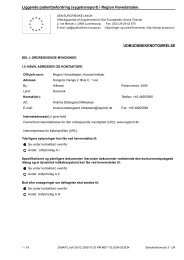Territorial Review Copenhagen - Region Hovedstaden
Territorial Review Copenhagen - Region Hovedstaden
Territorial Review Copenhagen - Region Hovedstaden
Create successful ePaper yourself
Turn your PDF publications into a flip-book with our unique Google optimized e-Paper software.
157<br />
Box 2.5 Some examples of congestion charges in OECD countries<br />
Road pricing is a programme whereby the government directly charges users<br />
for using a congested section of a transportation network during a congested<br />
time. Road pricing attracts more attention because of the rather recent<br />
introduction of congestion charges in London and Stockholm. The purpose of<br />
the congestion charge is not only financing and funding road infrastructure but<br />
also introducing demand management in transportation system. By charging for<br />
use of the congested section and hours, government can deter drivers from using<br />
those sections. Reducing the impact of the congested traffic on the environment<br />
and health is often an additional objective. Governments often use revenues<br />
generated by the charge for the expansion and improvement of mass transit<br />
network.<br />
The case of London has been widely analysed in public policy debate. The<br />
following conditions made the implementation feasible in the context of<br />
London.<br />
<br />
<br />
Severe transportation bottlenecks in the city centre: road congestion<br />
was severe, while the expansions of roads were extremely difficult<br />
because of the already crowded built environment.<br />
Transportation structure (cars and other modes of transport):<br />
Relatively good alternatives to private cars existed, such as walking,<br />
cycling, taxi, bus, and subway. Only about 10% of peak period trips<br />
were made by private car. Many of the automobile commuters were<br />
living outside the city. The city did not have much residential<br />
population inside the area compared to the outer area. While a wide<br />
array of people benefited from the congestion decrease, the people<br />
who elected to pay the congestion charge were limited.<br />
<br />
<br />
<br />
<br />
<br />
Political will: The leadership of Mayor Ken Livingstone was strong<br />
and consistent through the process. He also integrated the congestion<br />
charge into the wider scheme of London Plan and Mayor‘s Transport<br />
Strategy, to make his claim convincing and appealing.<br />
Legislative support from the national government: The national<br />
government provided the Greater London Authority (GLA) with the<br />
authority to introduce the congestion charge through the Greater<br />
London Authority Act of 1999 and Transport Act of 2000.<br />
Extensive public consultation: The GLA ensured understanding and<br />
support of the public and business in the decision-making process.<br />
Appropriate institutional setting: A professional team in Transport for<br />
London supported the management of system.<br />
Technological development: Technological development and the<br />
accompanying price decrease of facilities for congestion charge<br />
management made the implementation feasible.

















